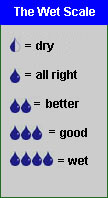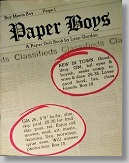"The clearest way into the Universe,
is through a forest wilderness."
-John Muir
|
| 

| 
As summer advances toward autumn and the start of a new school year, so can the boredom for children and parents both. Activities that were fun and engaging in June, often feel like tedious "done-thats" by August. Here, in an effort to preserve the sanity of all, are a smattering of activity books for young and old alike. September's just around the corner; let's get there mentally intact.
First published in Spain (1969), Working With Paper made its American publishing debut in 1971. It's a colorful guide with ideas for paper projects that range from simple to advanced. Each project is provided with clear instructions - both in text and pictures - and a list of materials to practically guarantee success.
Included are instructions for doing origami; paper mobiles; sculptures; puppets; dolls . . . ninety projects in all. In no time, you'll be folding, tearing, rolling and cutting your way to paper art pieces you'll be proud to display as your own, or give as gifts. Working With Paper is the first volume in Franklin Watts' Color Crafts series, and worth an extensive search of your local used book store for.
Here's a coloring book worth mentioning. In its pages you'll not find the caricatures of Native Americans that were common in cartoons and coloring books a generation ago. Despite its name, the illustrations of Native Americans in A Coloring Book of American Indians are dignified. Taken from historical illustrations done by America's First Peoples themselves, and sketches by early explorers, there's nary a wide-eyed, buck-toothed, tomahawk-at-the-ready native in the whole lot.
NEW IN TOWN. Good-lkng. GM, hzl eyes & boyish, seeks comp. to wine & dine. 25-35. Loves good food, fun, close friends. Box 18.
So reads the personal ad on the cover of Paper Boys: A Paper Doll Book. Conceptualized by Lynn Gordon way back in the dark ages (the 1980s; and they were dark days for the gay community, what with AIDS, Anita Bryant, and the advent of spandex), it was a publication that braved full immersion into uncharted waters when most "trailblazers" barely dared to dip a toe. And that it turned up at a B. Dalton Bookseller (think ultra-conservative national bookstore chain with homophobic tendencies) in a church-going, middle-class suburb of Seattle is truly mind-boggling.
Or miraculous. (Well, maybe not miraculous. After all, Boy George was all the rage mid-eighties, and ultra-conservative mega-chains do - regardless of their claim to a moral high ground - put making money ahead of everything else, so it probably didn't require a crystal ball in 1984 to predict they'd be peddling paper doll books featuring gay characters beside popular teen and music magazines selling fashion tips from the members of Culture Club. However, that was also the year I was threatened with termination - I worked for said bookseller - by a well-heeled upper management type who was doing a scheduled store inspection for corporate. He was groused - or was it aroused? - that I was sporting blonde bangs against my naturally overall mousey hair tone. Says he: "It's not natural." Says I . . . well, I didn't say anything.
I just directed his attention to the magazine section and its plethora of covers graced with the image of Boy George in full regalia. Really? A blonde streak in my bangs is the problem? But I digress.)
Paper Boys introduces us to David (a mustached Freddie Mercury type), Bruce (a smooth-skinned boyish type), and Cecil B. DeMutt (their dog). David and Bruce are roommates who share a bed. With wardrobe, furnishings and even beverages in outline for easy cutting, Paper Boys lends new definition to the term "ready-to-wear." Gay or straight, it won't be a challenge to find the humor of this book. Rather, the challenge will be finding a copy with its cut-outs - all thirty-nine of them - intact.
posted 08/08/22
 TOP |


